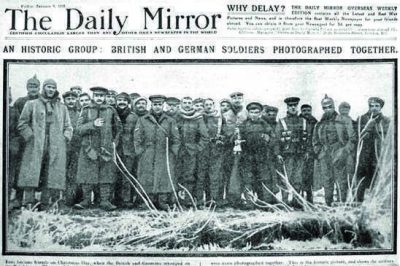The Misuses of History: The Christmas First World War 1914 Truce

All memorialised events, when passing into mythology, must be seen critically. In some cases, there should be more than a hint of suspicion. The Christmas Truce of 1914 remains one sentimentalised occasion, remembered less to scold the mad mechanised forces of death led by regressive castes than to reflect upon common humanity.
Common humanity, left to be butchered before the next grand stratagem, is the first casualty of the war room and, in many cases, parliaments. These are places where commemoration ceremonies are drafted and encouraged; they are also the places where the common soldier is left for ruin.
The Christmas Truce of the First World War arose out of a blood-bathed irony: the troops from both sides, Allies and German, were not meant to be slaughtering each other at that point. They should have been home to celebrate their respective victories or lick respective wounds. The diplomats and politicians could then celebrate what was meant to be a puerile skirmish waged in conditions more reminiscent of an old cavalry charge than mud-soaked death.
Pope Benedict XV, after his election on September 3, 1914, kept busy attempting to halt a war he deemed “the suicide of civilized Europe.” In December, he attempted, in vain, to persuade the belligerents to halt the murderous party, asking “that the guns may fall silent at least upon the night the angels sang.” This would be a prelude to discussions towards an honourable peace.
The sequence written about and recalled every year with the monotonous reflection of a prayer goes something like this: Stille nacht, heilige nacht comes from the German side of the trenches at the Ypres Salient. (The Hun proved troublingly festive and did not seem up for the killing.) The British, initially wary, show interest. Shots are not fired. The First Noel comes in reply. “Then,” remembered a British soldier, “we started up O Come All Ye Faithful and the Germans immediately joined in singing the same thing to the Latin words of Adeste Fideles.”
The gestures were repeated along the Western Front in pockets of small “truces”. British, German and French soldiers, in open defiance of orders, went to No Man’s Land in a spiritual reclamation of sorts under the pretext of burying the dead. An economy of gifting came to the fore: tobacco and chocolate; beer and pudding; sausage and Christmas trees; badges and buttons. The Allies were astonished by the goods they could receive in the exchange: the German armies were, at that point, better supplied.
Then came the football matches, though the legend here is inflated. Socks wrapping a tin of bully beef, for instance, were substitutes for soccer balls. The scores at these matches remain a subject of conjecture, as do the matches themselves.
Peter Stanley of the University of New South Wales, when asked about the record in 2014, suggested that such matches would have taken place behind the respective lines of the soldiers, if, in fact, they took place at all. The papers of the day ran “pictures of the truces, with lots of photos of men smoking but no photos of soccer matches. So what does that tell you?”
But Stanley’s insistence does not withstand the accounts of some subalterns, who describe scenes, not of 10-a-side but “a question of 70 Germans against 50 Englishmen” involving a ball with an adventurous fate. In January 1, 1915, The Times received a letter from an anonymous major that an English regiment “had a football match with the Saxons, who beat them 3-2.” (At least, mused historian Gerard DeGroot, “it did not end in penalties.”)
The legacy of the truce is somewhat estranged. While it might well have been the last gasp of civility in modern warfare – if you fall for that notion that civility was ever a part of the killing business – the truce has become a matter of commercialisation and celluloid. There are films such as the 2005 French film Joyeux Noel. Then come the commodities.
Supermarket chains such as Sainsbury’s have found the prospect of making money out of the memory irresistible. A 2014 ad, specifically, was reviled and yet admired by The Guardian for its “startling array of emotional depth within a few short minutes” marked by “breathtaking” cinematography. Slaughter might be futile, fought in the name of obscene abstractions, but making money is as clear enough a mission as any.
The truce compelled Arthur Conan Doyle to deem it “one human episode amid all the atrocities which have stained the memory of the war.” But it remains an episode celebrated with lessons to be ignored. The classroom of history troubles the demagogues and political practitioners, as it did those war planners in 1914 alarmed by the loss of faith in killing shown by the truce makers. Political figures and generals could not; soldiers could.
In many instances, the participating units in question were relieved by fresh men untainted by the temptation of mutual respect. As the war wore on in all its barbarity, such truces became infrequent. The enemy had to be hated. Common humanity, so goes that most salient lesson of all, remains a common mineral to be exploited and manipulated rather than revered.
Dr. Binoy Kampmark was a Commonwealth Scholar at Selwyn College, Cambridge. He lectures at RMIT University, Melbourne. Email: [email protected]

